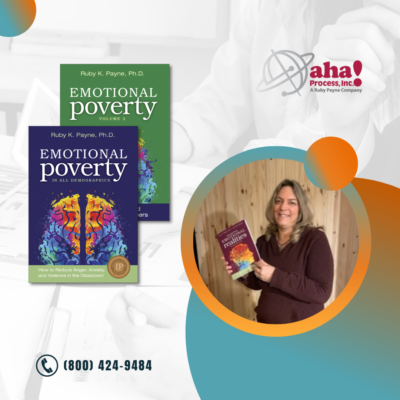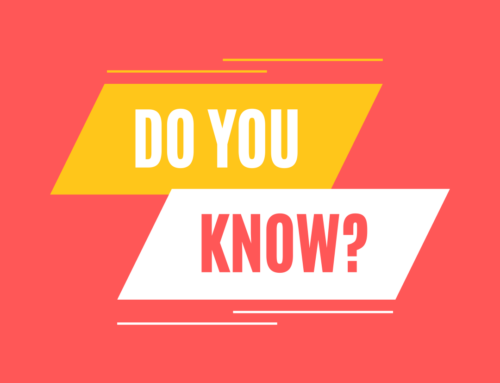The following is a portion of an interview with Amy Finn, program facilitator with Northwest Special Education Cooperative in Elizabeth, Illinois. The interview was conducted by Lynn Jackson, Bridges engagement manager at aha! Process. The interview has been edited for length and clarity.
 Lynn Jackson: Amy, thanks for joining me today. I would like to give you the opportunity to say a little bit about yourself.
Lynn Jackson: Amy, thanks for joining me today. I would like to give you the opportunity to say a little bit about yourself.
Amy Finn: Thank you so much. My name is Amy Finn, and I have been an educator for nearly 30 years. The past 16 years I have spent as the program facilitator for a day treatment program in northwest Illinois. We serve the needs of kids with emotional disabilities for 12 member districts in our area. I am so excited to be able to talk about the book and workshop, Emotional Poverty, and the effects that it’s had on our school. So thank you for the invite.
Lynn Jackson: Tell me how you’re using this in your own school.
Amy Finn: Absolutely. I went to Milwaukee, Wisconsin, probably two years ago now, and I got to hear Ruby Payne give a six-hour presentation on Emotional Poverty. Within the first 30 minutes, I was hooked because a lot of it was processes that we were using. I just didn’t have a name or any data to back it up. So as soon as she started talking, I realized it really fit in line with what we were doing at Northwest Academy.
We talk a lot about a regulated and an unregulated brain when our little ones are hurting. So for our younger ones that are first grade to probably fourth grade, I may just hold up my hand, and when they’re angry, I’ll say, did your brain kind of feel like that? Are you feeling unregulated right now? What can we do to help you get back to feeling regulated? And then we go through the steps of the hand model that are in chapter one. I love it.
Our older students actually understand what happens in the hippocampus area and the amygdala and what’s going on with our cortex and our prefrontal cortex. And then they’re able to kind of talk it through so that when they’re unregulated and we’re ready to start talking, we can talk about strategies that we’re going to use to get them back in a regulated state. So our older students actually model the hand model as part of their consequences after they’ve worked through a behavior.
Lynn Jackson: Thank you for the examples. It’s wonderful that you’ve taken the information that you heard and that you’re embedding it, you’re using it, you know, with the students that you see on a daily basis.
Amy Finn: It’s been a pretty phenomenal thing to watch happen because I think our students really need, when they’re having a behavior, they need to be able to separate from being like a bad kid. You know, we just don’t use those terms. That’s not how we feel at all. We really feel that they’re unregulated during a behavior and they just need the communication to be able to explain what’s going on during that time. So it’s really afforded them an opportunity to better understand how their brain’s working and why.
Lynn Jackson: Amy, obviously you are using the information professionally, you understand it, and that’s one of the reasons that we are working with you at the national level, having you out and presenting the information. So as you think about yourself as a presenter, what are things that you want people to know as they invite you into their school district?
Amy Finn: I get excited when I think about talking with fellow educators. I think you can learn so much from each other. And having worked with behaviors for such a long period of time and being able to use the strategies in the book, watch them work firsthand and then share specific examples with folks, I believe that kind of helps us connect as educators, and those are things they feel more comfortable trying in their classrooms as well. We had a little guy not too long ago sitting in an English class learning about family systems as part of an English lesson. He’s an eighth grader, and out of nowhere, he just threw his desk and his papers went flying and he stormed out of the room and went to our safe area where we can talk through behaviors. When he got down there, I met him there and I just said, when you are ready, let us know.
I think that’s really important. When a student is unregulated, they’re certainly not ready to talk yet. So we gave him time. When he was ready, he said, “I’m ready.” We began to talk about what happened during that time, and believe it or not, he was sitting there. It’s November, and as I mentioned earlier, they’re talking about family systems, and he starts to worry about how he is going to get a Father’s Day card to his dad. Now we all knew Father’s Day was not for a while, months away, but for him, he couldn’t think about anything else until he had that fixed. We were able to come up with a solution. We made him a card that day. I put it in my desk. I told him that I would find a way to get that to his dad in June. He would not need to worry about that part any longer. He felt really comfortable with that, and he was able to go back to class.
Some things that we did while we were strategizing: First, we gave him water to help bring his cortisol levels back down. We know that’s a calming strategy in the Emotional Poverty book, and it works like a charm. So when I come to talk in your schools and your classrooms, those are the strategies I’m going to share with you because they’ve worked for us while he was drinking his water. He was able to tell us what was going on. We strategized ways to fix it, but most importantly, we don’t ignore that the behavior happened or that there’s a consequence. We certainly have a consequence for throwing papers in a desk all over a room. So, he did have to work through those consequences, but not until he was more regulated and we were able to use a few of the strategies. We also, with him, wrote and jotted a future storyboard many weeks prior because he needed that, and we were able to pull that visual storyboard back out and look at what he was really trying to accomplish. Tipping a desk in the classroom wasn’t going to help him accomplish that. We got that visual storyboard back out. This is another key piece of the book that I’d be happy to share in detail with educators.
______________________________________________________________________________
Emotional Poverty discusses brain regulation, integration, and emotional competence. The book provides tools to motivate good behavior.
Call (800) 424-9484 to book Amy for your next Emotional Poverty professional development workshop.








